Malcolm R. Campbell's Blog, page 202
July 26, 2015
Basing decisions on Facebook LIKES
In her blog The Green Bough, Oriah writes that “We do not need permission to live our life guided by that which lives within us.” Nonetheless, she believes we often wait for it or ask for it.
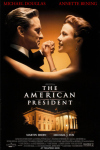 In the 1995 movie “The American President,” Michael Douglas (the widowed President) wants to date Annette Bening (a lobbyist). When he mentions this to Martin Sheen (his chief of staff), Sheen offers to “crunch some numbers” to see how much of a “hit in the polls” the President would suffer. It’s both an amusing moment and a strong hint about what our leaders must think about day to day.
In the 1995 movie “The American President,” Michael Douglas (the widowed President) wants to date Annette Bening (a lobbyist). When he mentions this to Martin Sheen (his chief of staff), Sheen offers to “crunch some numbers” to see how much of a “hit in the polls” the President would suffer. It’s both an amusing moment and a strong hint about what our leaders must think about day to day.
After all, we put them in office to serve us.
On Facebook, I see pages (everything from organizations to public figures to authors) seeking more and more LIKES. LIKES rule the roost on Facebook for, without them, status updates from official PAGES and personal PROFILES get less play in the daily news feed.

New conscience or new god?
When people post political statements and/or platitudes, they often come with the suggestion to LIKE AND SHARE if we agree. Of course, this gets the word out about the new book, the petition drive, the cause or the event.
What gives me pause are those posts in which an individual is thinking of changing jobs, pondering a new point of view, ditching a lover or wondering whether they were too harsh or too lenient with a friend, child, spouse or co-worker. How do we help? With LIKES and associated comments.
I’m not sure this is a good way to live, crunching Facebook LIKES, so to speak, before we do or say what he already know we want to do or say. Do we really need permission from our online friends or even our non-virtual friends before we can act?
I hope not. Life isn’t an on-going political campaign or popularity contest, I don’t think. We know who we are without checking Facebook or crunching real and virtual LIKES.
Yes, it was funny in the movie; but when I see it happening on Facebook, it’s a bit frightening.
–Malcolm


July 23, 2015
Historic Cabin Destroyed by Glacier Park Fire
The 4,000-acre (as of 7/23/2015) Reynold’s Creek Wildland Fire in Glacier National Park’s St. Mary Valley has destroyed the historic Baring Cabin. Also called the Sun Camp Fireguard  Cabin, this National Register listed property was built in 1935 as part of a compound of buildings used by the park service.
Cabin, this National Register listed property was built in 1935 as part of a compound of buildings used by the park service.
It was the last remaining structure before being destroyed by the fire on 7/22 that–according to latest reports–has come within 200 feet of Rising Sun Motel and is being moved by high winds toward the now-evacuated village of St. Mary at the junction of Going-to-the-Sun Road and highway 89 on the eastern side of Glacier Park. The cause of the fire has not been determined.
The cabin was built by Harry E. Doverspike at the mouth of Baring Creek, according to NPS Division of Landscape  Architecture specifications, a mile east of the Going-to-the-Sun Chalet. The chalet as removed in 1948. The cabin, which has housed park personnel on an as-needed basis, was fully staffed into the early 1960s.
Architecture specifications, a mile east of the Going-to-the-Sun Chalet. The chalet as removed in 1948. The cabin, which has housed park personnel on an as-needed basis, was fully staffed into the early 1960s.
The 20×25-foot cabin (including a covered porch) was built in the rustic architecture style and featured a stone foundation and chimney, log walls and a singled roof.
It was listed on the National Register in 1999 based on its history and architecture.
While the Blackfeet name for the creek is ápa-oápspi (weasel eyes), the name “Baring” was applied to the creek and the falls in honor of the old-line banking family who visited the area frequently during the 1920s. Author and explorer James Willard Schultz (Apikuni) named the creek, falls and nearby glacier (since changed to Sexton).
You can track the fire on this frequently refreshed map.
–Malcolm


A something or other with no name
“To name a thing is to acknowledge its existence as separate from everything else that has a name; to confer upon it the dignity of autonomy while at the same time affirming its belonging with the rest of the namable world; to transform its strangeness into familiarity, which is the root of empathy. To name is to pay attention; to name is to love.” – Maria Popova in How Naming Confers Dignity Upon Life and Gives Meaning to Existence
We tend to view the world through the lens of our language. Students taking language classes are often surprised that many of their pet phrases and notions have no twin in the language they’re being taught. Why not? The native speakers of that language see the world differently. My stories about, say, Glacier National Park, would be much different if they had been written in Blackfeet or Kootenai.
As a storyteller (writing in English for others who speak English), I see that naming things is both a sign of respect and acknowledgement as well as a limiting factor. When you name a mountain “Chair Rock,” you’re doing a normal thing. But you’re also making it difficult to see the rock any other way. If you see a translation of a story that includes “Chair Rock,” the name may suddenly be further away from your world view than the author will ever know.
In many cultures, people hide their true names–sometimes called “basket names”–from people outside the family because those names are linked to their true selves and telling them gives others a power over you. I can respect that. When I write, there is much that I refuse to say.
There’s an old gag about Dewey Bunnell’s song “A Horse with No Name,” recorded by America in 1971, that what with all that time in the desert, couldn’t the guy name the horse?
It’s hard to visualize the song, originally called “Desert,” with a horse named Fury or Flicka or Mr. Ed. Perhaps he didn’t respect the horse other than to say he was, in fact, riding a horse rather than something or other. Or, perhaps, the horse didn’t want its true name to be known.
Here, I’m respecting Dewey Bunnell and America by mentioning them. For a writer, that’s intentional because–as is often the case–those names have been forgotten while–in this case–the song is still widely known.
The specifics we include in our storytelling are there not because we are are name dropping or “adding a bunch of description” (as some call it) or playing with a place names dictionary or a “this date in history” website.
They are in the story because they confer the “dignity of autonomy” and because they’re an affirmation of their existence, as Maria Popova calls it. The realities in a story tie the story to a time and place as part of what happened their or how the world moved there. They are also in the story because the characters living in that time or place would know them and have empathy for them–as perhaps you, the reader, will know them as you read.
I included a glossary in the back of Conjure Woman’s Cat because the story includes folk magic terms, blues songs and performers’ names that they characters in the story would know. If Conjure Woman’s Cat were nonfiction, I could have included footnotes. The glossary seemed less distracting.
Part of research is changing what a writer knows about his or her story in progress from a something or other to something specific and loved and known within the context of the tale and the language in which it’s told. To paraphrase Jim Croce, like the pine trees and the croaking toad, everything in the story has a name.
If an author gets those names right, s/he can immerse you into the real and/or fictional world where those names arise even though–like maps–they’re not the territory.
–Malcolm
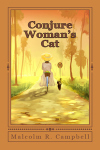
 Malcolm R. Campbell is the author of “Conjure Woman’s Cat” and “Emily’s Stories.”
Malcolm R. Campbell is the author of “Conjure Woman’s Cat” and “Emily’s Stories.”


July 19, 2015
Top Five Magical Realism Books at Amazon
If you’ve heard about magical realism, but haven’t knowingly sampled it yet, the top sellers on Amazon are a wonderful place to start.
T
 he Night Circus, by Erin Morgenstern, September 2011. I read this as soon as it came out and it became one of my favorite books. It edged out The Tiger’s Wife as that year’s favorites as I wrote in this post. The fact that it’s still number one, shows it has staying power and that people continue to find it. It has a long list of starred reviews, telling me the critics also like it. A circus shows up out of nowhere, displays breathtaking feats of real magic as though they are mere illusions, and then disappears. What a joy to read.
he Night Circus, by Erin Morgenstern, September 2011. I read this as soon as it came out and it became one of my favorite books. It edged out The Tiger’s Wife as that year’s favorites as I wrote in this post. The fact that it’s still number one, shows it has staying power and that people continue to find it. It has a long list of starred reviews, telling me the critics also like it. A circus shows up out of nowhere, displays breathtaking feats of real magic as though they are mere illusions, and then disappears. What a joy to read. The Mermaid’s Sister, by Carrie Anne Noble, March 2015. This book is the 2014 Winner of Amazon’s Breakthrough Novel Award for Young Adult Fiction. I haven’t read it yet, but I’m impressed with the general tone of the reviews and what I can see via the book’s “Look Inside” feature. The cover is delightful and the publisher’s opening words about the story are tempting: “There is no cure for being who you truly are…In a cottage high atop Llanfair Mountain, sixteen-year-old Clara lives with her sister, Maren, and guardian Auntie. By day, they gather herbs for Auntie’s healing potions. By night, Auntie spins tales of faraway lands and wicked fairies. Clara’s favorite story tells of three orphan infants—Clara, who was brought to Auntie by a stork; Maren, who arrived in a seashell; and their best friend, O’Neill, who was found beneath an apple tree.”
The Mermaid’s Sister, by Carrie Anne Noble, March 2015. This book is the 2014 Winner of Amazon’s Breakthrough Novel Award for Young Adult Fiction. I haven’t read it yet, but I’m impressed with the general tone of the reviews and what I can see via the book’s “Look Inside” feature. The cover is delightful and the publisher’s opening words about the story are tempting: “There is no cure for being who you truly are…In a cottage high atop Llanfair Mountain, sixteen-year-old Clara lives with her sister, Maren, and guardian Auntie. By day, they gather herbs for Auntie’s healing potions. By night, Auntie spins tales of faraway lands and wicked fairies. Clara’s favorite story tells of three orphan infants—Clara, who was brought to Auntie by a stork; Maren, who arrived in a seashell; and their best friend, O’Neill, who was found beneath an apple tree.” Hear the Wind Sing and Pinball, by Haruki Murakami are two novels issued in this one volume set for release next month. They haven’t previously been available in English. According to the publisher, “These powerful, at times surreal, works about two young men coming of age—the unnamed narrator and his friend the Rat—are stories of loneliness, obsession, and eroticism. They bear all the hallmarks of Murakami’s later books, and form the first two-thirds, with A Wild Sheep Chase, of the trilogy of the Rat.” I am tempted by this book, but more tempted by the book sitting in position number five.
Hear the Wind Sing and Pinball, by Haruki Murakami are two novels issued in this one volume set for release next month. They haven’t previously been available in English. According to the publisher, “These powerful, at times surreal, works about two young men coming of age—the unnamed narrator and his friend the Rat—are stories of loneliness, obsession, and eroticism. They bear all the hallmarks of Murakami’s later books, and form the first two-thirds, with A Wild Sheep Chase, of the trilogy of the Rat.” I am tempted by this book, but more tempted by the book sitting in position number five. God Help the Child, by Toni Morrison, April 2015. I have read most of Morrison’s work and have this book on order. While the cover is disappointing, the reviews are positive. The publisher describes the book this way: “At the center: a young woman who calls herself Bride, whose stunning blue-black skin is only one element of her beauty, her boldness and confidence, her success in life, but which caused her light-skinned mother to deny her even the simplest forms of love. There is Booker, the man Bride loves, and loses to anger. Rain, the mysterious white child with whom she crosses paths. And finally, Bride’s mother herself, Sweetness, who takes a lifetime to come to understand that ‘what you do to children matters. And they might never forget.’” I’ll stipulate that so far, I’ve only read what I can see via “look inside,” but based on that, I think it will be difficult for any author in 2015 to match the power of this story.
God Help the Child, by Toni Morrison, April 2015. I have read most of Morrison’s work and have this book on order. While the cover is disappointing, the reviews are positive. The publisher describes the book this way: “At the center: a young woman who calls herself Bride, whose stunning blue-black skin is only one element of her beauty, her boldness and confidence, her success in life, but which caused her light-skinned mother to deny her even the simplest forms of love. There is Booker, the man Bride loves, and loses to anger. Rain, the mysterious white child with whom she crosses paths. And finally, Bride’s mother herself, Sweetness, who takes a lifetime to come to understand that ‘what you do to children matters. And they might never forget.’” I’ll stipulate that so far, I’ve only read what I can see via “look inside,” but based on that, I think it will be difficult for any author in 2015 to match the power of this story. Mr. Penumbra’s 24-Hour Bookstore (audio version), by Robin Sloan, October 2012. I read this book when it came out and found the story and characters strange and compelling. I don’t care for the cover but, like Morrsion’s book, the reviews are positive. And, what can be more tempting for an author than a publisher’s description that (1) starts out like this: “A gleeful and exhilarating tale of global conspiracy, complex code-breaking, high-tech data visualization, young love, rollicking adventure, and the secret to eternal life—mostly set in a hole-in-the-wall San Francisco bookstore” and (2) begins like this: “Lost in the shadows of the shelves, I almost fall off the ladder. I am exactly halfway up. The floor of the bookstore is far below me, the surface of a planet I’ve left far behind. The tops of the shelves loom high above, and it’s dark up there–the books are packed in close, and they don’t let any light through. The air might be thinner, too. I think I see a bat.” I hope the world will always have bookstores that can be described this way. The book kept my attention, but not enough to re-read it as I have The Night Circus.
Mr. Penumbra’s 24-Hour Bookstore (audio version), by Robin Sloan, October 2012. I read this book when it came out and found the story and characters strange and compelling. I don’t care for the cover but, like Morrsion’s book, the reviews are positive. And, what can be more tempting for an author than a publisher’s description that (1) starts out like this: “A gleeful and exhilarating tale of global conspiracy, complex code-breaking, high-tech data visualization, young love, rollicking adventure, and the secret to eternal life—mostly set in a hole-in-the-wall San Francisco bookstore” and (2) begins like this: “Lost in the shadows of the shelves, I almost fall off the ladder. I am exactly halfway up. The floor of the bookstore is far below me, the surface of a planet I’ve left far behind. The tops of the shelves loom high above, and it’s dark up there–the books are packed in close, and they don’t let any light through. The air might be thinner, too. I think I see a bat.” I hope the world will always have bookstores that can be described this way. The book kept my attention, but not enough to re-read it as I have The Night Circus.There’s a lot to like here if you’re of a mind to sample the latest magical realism. Then, stop by Malcolm’s Round Table on July 29 when I’ll be taking part in a magical realism blog hop.
–Malcolm
 Malcolm R. Campbell is the author of the magical realism novella set in the Jim Crow era of the Florida Panhandle, “Conjure Woman’s Cat”
Malcolm R. Campbell is the author of the magical realism novella set in the Jim Crow era of the Florida Panhandle, “Conjure Woman’s Cat”
See the Indie View interview about how I write and why I wrote this book.


July 18, 2015
Listen, writers, this is gospel or my name’s not John Doe
A Facebook friend of mine claims that every story you want to write is sitting “out there” in limbo or maybe Topeka waiting for you to discover it, copy it into a DOCX file, and send it off to HarperCollins for $1000000000000000.
Does that sound crazy or what?
 Far be it from me to dispute it because the gospel truth is stranger than fiction. Working writers use meditation, dreams, magic, quantum entanglements and whiskey to meet with their characters once a month and talk about stories. Think of these people as, not beta readers, but beta writers.
Far be it from me to dispute it because the gospel truth is stranger than fiction. Working writers use meditation, dreams, magic, quantum entanglements and whiskey to meet with their characters once a month and talk about stories. Think of these people as, not beta readers, but beta writers.
Every one of them has ideas. Like actors, they all want to direct. These meetings are like casting calls (when you have a new story to write), brainstorming sessions (when one of them wants to run an idea of the flagpole) or encounter groups (when the sock puppets get out of control).
It’s completely safe because weapons are checked at the front door and watched over by a guy who looks like Dirty Harry. If you get too close to the guns, he says, “Well, you gotta ask yourself, do you feel lucky punk?”
 I meet with my characters at a seafood joint called The Oaks in Panacea, Florida. The real Oaks has been closed for years, but with powerful meditation techniques and/or a shot of Scotch, the place returns out of the Ochlockonee River mist with the same reality that Brigadoon appeared to Tommy Albright and Jeff Douglas in the Scottish Highlands.
I meet with my characters at a seafood joint called The Oaks in Panacea, Florida. The real Oaks has been closed for years, but with powerful meditation techniques and/or a shot of Scotch, the place returns out of the Ochlockonee River mist with the same reality that Brigadoon appeared to Tommy Albright and Jeff Douglas in the Scottish Highlands.
Since Eulalie (Conjure Woman’s Cat) is the best cook, she fixes fried mullet, hush puppies and slaw for the crowd while we shoot the breeze over old times, swap recipes for cathead biscuits and saw mill gravy, and stay away from the guy guarding the weapons.
Last night, Eulalie asked how her next story was coming along and I had to tell her it was running behind schedule. Emily (Emily’s Stories) said I promised her she could look for ghosts at the old Perkins Opera House in Monticello, Florida. “I know where it’s hiding,” she said.
 Ruby (The Seeker) wanted to know why she didn’t didn’t have a part in Snakebit. “Anne and I are like family,” she reminded me. “Who the hell do I have to sleep with to get another story?”
Ruby (The Seeker) wanted to know why she didn’t didn’t have a part in Snakebit. “Anne and I are like family,” she reminded me. “Who the hell do I have to sleep with to get another story?”
Laurence Adams (The Sun Singer) showed up even though his story doesn’t take place in Florida and said, “If you had finished writing another story set in Glacier National Park, it would be selling like hot cakes this summer during the hotel’s 100th anniversary. Please tell me you people aren’t eating mullet. High class Floridians don’t even eat mullet.”
You can see why we check our weapons at the door.
Okay, here’s what you do.
 Choose a real place for your meeting. Make sure the owners (if any) don’t know about the meeting.
Choose a real place for your meeting. Make sure the owners (if any) don’t know about the meeting.If you know the names of your characters or prospective characters, write them on a piece of paper in blood (hopefully not yours) and bury it (the paper) in a deserted graveyard while nobody’s watching. If you are looking for fresh ideas, include words like “Chainsaw Killer,” “Honest Lawyer,” and “Sexy Vixen.”
Steal somebody’s meditation techniques off the Internet and suddenly feel like your eyes are getting tired, that your brainwaves are entering the alpha state, and that you can “see” your meeting hall filling up with wonderful people and probably a feel wannabees. (Don’t over-do the meditation and go into a stupor.)
Check all weapons.
After finishing your favorite foods and beverages, ask your current and prospective characters if they believe stuff like “every story you want to write is sitting ‘out there’ in limbo or maybe Topeka waiting for you to discover it, copy it into a DOCX file, and send it off to HarperCollins for $1000000000000000.”
When they say, “Does that sound crazy or what?” tell them you’re ready to hear some better ideas. Listen carefully with an open mind and an open heart. (This means not saying, “Hey, dirtbag, what kind of bozo idea is that.”)
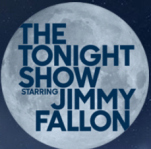 Now, listen, writers, this is gospel or my name’s not John Doe: When you come out of your meditation (assuming you come out of it), you will have the best darned ideas for the best darned stories in the best of all possible worlds.
Now, listen, writers, this is gospel or my name’s not John Doe: When you come out of your meditation (assuming you come out of it), you will have the best darned ideas for the best darned stories in the best of all possible worlds.This is important: Don’t discuss your new idea with anyone specially friends and family for they’ll share it with everyone and before you know it, some clown from Chicago or Miami will be sitting in a chair on the “Tonight Show” telling the world about YOUR BOOK. Well, it would have been your book if hadn’t blabbed the storyline to people who can’t keep a secret.
Write the thing. Then give Jimmy Fallon a call. I know, I know, he’s no David Letterman or Johnny Carson, but he’s probably good for couple hundred grand in sales.
There you go.
–Malcolm

 Malcolm R. Campbell is the author of the Jim Crow era novella, “Conjure Woman’s Cat,” which is on sale on Kindle today (July 18th) for only 99 cents. Eulalie claims she gets a 50% cut of the action or else.
Malcolm R. Campbell is the author of the Jim Crow era novella, “Conjure Woman’s Cat,” which is on sale on Kindle today (July 18th) for only 99 cents. Eulalie claims she gets a 50% cut of the action or else.


July 15, 2015
Review: ‘Go Set a Watchman,’ by Harper Lee
“One learns one’s mystery at the price of one’s innocence.” ― Robertson Davies
The mockingbird dies again in Go Set a Watchman.
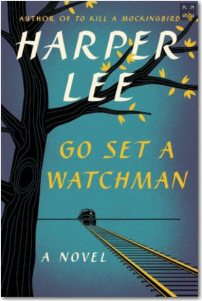 In To Kill a Mocking Bird, Jean Louise “Scout” Finch, Jeremy Atticus “Jem” Finch and Charles Baker “Dill” Harris are among the innocent mockingbirds who suffer when the cruel realities of life intrude into their childhoods after Atticus is appointed by the court to defend a Black man accused of raping a white woman.
In To Kill a Mocking Bird, Jean Louise “Scout” Finch, Jeremy Atticus “Jem” Finch and Charles Baker “Dill” Harris are among the innocent mockingbirds who suffer when the cruel realities of life intrude into their childhoods after Atticus is appointed by the court to defend a Black man accused of raping a white woman.
The trial and its aftermath represent a defining moment for the fictional Maycomb, Alabama; establish Atticus as the watchman who sees the truth and crusades for justice; and solidifies for young Scout, her faith in a wise and loving father who can do no wrong.
In Go Set a Watchman, the twenty-six-year-old Jean Louise who lives and works New York returns to Maycomb to visit her ailing father at a time when there are increasing tensions in the South after the Supreme Court’s Brown v. Board of Education (1954).
Lee paints a clear picture of the concerns many small town residents had about the ramifications of desegregation. Some reviewers have skewed the point of the book by looking at these not-unusual 1950s beliefs through a 2015 microscope.
While this makes for sensationalistic headlines, it inaccurately clouds the realities of the time period for prospective readers.
Scout, who is basically color blind, believes what she grew up thinking Atticus believed: “Equal Rights for all, special privileges for none.” When it comes to matters of law, he has not wavered. Daily life, though, isn’t the law to his way of thinking. When Scout discovers Atticus thinks Blacks are not yet ready for the full rights of a desegregated society, her world is shattered. The man who wants to marry her has similar views and, along with her father, is attending political meetings aimed at finding ways to fight the Supreme Court’s ruling, The mysterious wonders of her childhood under the patient guidance of her father are suddenly at risk as everything she thought was true is potentially false.
Lost innocence and fallen gods are central themes in this book.
Like many debut novels, Go Set a Watchman contains a fair amount of back-story of “remember-when” discussions and reminiscences. While these passages inform the reader about what was, they also slow the pace of a novel. However, readers of To Kill a Mockingbird will probably also find these passages nostalgic as they shed more light on Mockingbird’s beloved cast.
After Scout learns what she learns about her father and his colleagues, she has a decision to make. She can run back to New York filled with hatred for the family and friends who have destroyed the remains of her innocence and her childhood memories with views she abhors. Or, she can stay in Maycomb, fight for what she believes, and as a watchman tell others the truths she sees among them.
Harper Lee deftly handles Scout’s dilemma in a wonderful novel that will, I hope, survive the perils of the misguided critics who have been shouting that the sky is falling.
Malcolm R. Campbell is the author of “Conjure Woman’s Cat,” a novella set in the Jim Crow 1950s of the Florida Panhandle in which granny and her cat fight racial injustice with folk magic.


July 9, 2015
Reviews for ratings or to explore something new?
The reviews on this blog have been a mix of new or unknown authors and books by recognizable names. Since this blog isn’t Beatrice or Bookslut, I don’t kid myself into thinking that my opinions about authors and their books will have an earthshaking impact in the scheme of things.
Since I’m not Beatrice or Bookslut, much less The New York Times or the Washington Post, I worry less about the impact of ratings. If I work for a widely known media outlet, I’lll be handed most of the books I review and most of those will be books that are probably doing well enough not to need a review.
On the other side of the coin, new authors need the exposure that reviews give them whether they come from readers on Amazon or bloggers like myself. I know how authors feel when they ask me to review their books and the next thing they see here is a review of a bestselling author.
I know because I’ve been there. My books have also gone to review sites that chose instead to review, in some cases, books that were several years old and already famous and already reviewed by everyone and their brother. I know, I know, that famous book is better for ratings, especially if you have advertisers that watch our market influence like hawks.
I’m not oblivious to ratings here. I don’t suppose this is a secret, but I do hope some of those who stop by this blog will like what they see and buy one of my books.
The BIG BOOKS I review here are books I bought, read, likely and felt like talking about. The authors won’t know I reviewed their book 99% of the time. But, like others who enjoy talking with their friends about the latest books “everybody’s reading,” it’s fun to toss in my two cents about J. K. Rowling or Dan Brown from time to time.
But I feel guilty when I do it. I see a lot of visitors with those posts, but I wasn’t bringing them anything new–just more talk about a book or an author that’s been reviewed everywhere else. I feel better, I think, when I can tell you about a book you haven’t heard of, but might like. Those posts get fewer visits and that’s discouraging.
I wasn’t born yesterday, so I know that people tend to read books everyone else is reading rather than experimenting with books none of their online and off-line friends have heard of.
A new author is always a risk. But there could be gold there even though The New York Times and Book Page and Publishers Weekly will never give that author a chance. But what an adventure it is to read something wonderful from a debut author. That’s part of the fun of reviewing books and deciding to go with something nobody’s ever heard of instead of the BIG BOOK has already sold 100000000000 copies.
So, how experimental in your reading are you?
Do you wait to see which books grab the mainstream reviewers’ and public’s attention and create your reading list from that group? Or, do you read descriptions of self-published and small press books and give them a try from time to time?
Curiously,
Malcolm


July 3, 2015
What we’ve got here is failure to communicate
It’s hard to believe the novel Cool Hand Luke is fifty years old and that the Paul Newman film is forty eight.
 We liked the book and the novel in the 1960s because we liked poking at the system. The chain gang where Luke serves his time is a bad system, personified, perhaps by the joint’s Captain played by Strother Martin. When something didn’t work out right, the Captain famously said, ‘What we’ve got here is failure to communicate.”
We liked the book and the novel in the 1960s because we liked poking at the system. The chain gang where Luke serves his time is a bad system, personified, perhaps by the joint’s Captain played by Strother Martin. When something didn’t work out right, the Captain famously said, ‘What we’ve got here is failure to communicate.”
We were all saying that in the 1960s every time the latest lie from “the establishment” came down the road to bite us.
“Luke: I wish you’d stop being so good to me, Cap’n.
“Captain: Don’t you ever talk that way to me. (pause, then hitting him) NEVER! NEVER! (Luke rolls down hill; to other prisoners) What we’ve got here is failure to communicate. Some men you just can’t reach. So you get what we had here last week, which is the way he wants it. Well, he gets it. I don’t like it any more than you men.”
 The book and movie seemed real because the author, Donn Pearce (Nobody Comes Back, 2005) served time after being convicted as a safe cracker.
The book and movie seemed real because the author, Donn Pearce (Nobody Comes Back, 2005) served time after being convicted as a safe cracker.
Kirkus Reviews’ Gregory McNamee looked back at Cool Hand Luke at 50. I wish I’d written the first paragraph of the essay:
“Donn Pearce’s Cool Hand Luke is a hot book. A hot, sweaty book. A hot, sweaty, stinking book. When you read it, having worked vicariously on a chain gang in a Florida July, you’ll want to take four or five showers—and you’ll give up any thought of a life of crime, especially one south of the Pee Dee and east of the Atchafalaya.”
I appreciated the story, in part, because I grew up in Florida and saw a lot of chain gangs working the roads. The Kirkus piece is called an interview, though that’s questionable since it doesn’t have any Q&A in it. I wish McNamee had contacted the 86-year-old author and ask him how the story speaks to us in 2015.
Goodness knows, the story should speak to us because, what with the near-weekly revelations of lies–and/or people who “misspoke”–we have plenty of reasons not to trust “the establishment” even if we don’t call it that any more.
In June, the Florida Department of Corrections said that it’s looking at a new model. It’s called “transformative rehabilitation.” Big words. Are they real, or another failure to communicate? Rather than simply managing the inmates’ time in jail, these words mean the inmates will be prepared to re-enter society.
We can hope without holding our breath. Our country is addicted to its prisons with more people in jail than any other modern, advanced nation. There are a lot of Lukes out there and that seems ensure the story will probably keep speaking to us.
–Malcolm
 Malcolm R. Campbell is the author of the novella “Conjure Woman’s Cat” set in the Jim Crow era of the Florida Panhandle.
Malcolm R. Campbell is the author of the novella “Conjure Woman’s Cat” set in the Jim Crow era of the Florida Panhandle.


July 2, 2015
Many Glacier Staircase Replacement: Vandalism or Restoration?
In May and June, Montana newspapers reported that the National Park Service, the Glacier National Park Conservancy and the National Park Foundation plan to restore the long-removed spiral staircase to Many Glacier Hotel’s lobby. The staircase connected the lobby with the lake level room below

Original double-helix staircase – NPS photo
Considered a defining feature of the lobby when the Great Northern Railway built the hotel in 1915 on the east side the park, the staircase was removed in 1957 to make room for a gift shop. Additional space in the lake level St. Moritz room, a rather unexpected benefit, was used for a stage which has over the years seen many professional performers and hotel-produced skits and plays. That stage, which will disappear if the staircase returns, is used nightly.
The May 4th story in the Flathead Beacon quotes a Glacier National Park spokesperson as saying, “This project will revive the historic look and feel of the hotel.”
Had this statement been made in the late 1950s and early 1960s, it would have been true. At the time, hotel employees and guests mourned the loss of the staircase and wanted to see it brought back.
This year, we can say, however, that the historic staircase was in place for 42 years and missing for 58 years. Which version of history is more authentic? In 1957, the staircase should not have been removed. In 2015, it should not be replaced.
Why not?

Current lobby showing the adjustable space next to the gift shop for performers – Barry Campbell photo.
Buildings evolve over time. If you look at many of the upgrades to the hotel made during the last several years, you’ll see evidence of change, in part, for purposes of structural integrity, building codes, safety and usability. Arguments for and against change rage in many areas of historic preservation from steam locomotives and old rail cars to historic homes and public buildings. What’s necessary to keep a building or an object safe/viable and what is over the line? The argument will never end.
To my knowledge, most projects proposed with Glacier National Park have included feasibility studies, impact statements, and the expected results of doing nothing or selecting one of the researched options. These planning documents are scoped by experts and disseminated to the public for comments. They allow time for dialogue.
This time out, it appears that the public has been excluded. As far as I can tell, the proposed staircase restoration project did not have a public comments period. If experts looked at it, their comments (pros and cons) have not been made available in any accessible document.
If experts looked at the staircase plan, they would have noticed that it violates a provision of the Secretary of the Interior’s Standards for Preservation. As the former chairman of a local historic preservation commission, I can say that these standards, promulgated and annotated by the National Park Service, are the basis for all properly done preservation or restoration projects.
The proposed plan appears to violate standard #4: Changes to a property that have acquired historic significance in their own right will be retained and preserved.
The hotel without the staircase did not become static in 1917. For one thing, both the lake-level St. Moritz room and the post-staircase lobby space have found many uses over the years. Today, you will find music and other performances in the extra lobby space as well as in the room below.

The porte cochère shown here allows people to get in and out of vehicles without getting wet. It wasn’t there when the hotel was built. Buildings evolve – Malcolm Campbell photo
Notably, during the twenty-three (1961-1983) years when Ian B. Tippet served as the hotel manager, Many Glacier became famous for its employee-produced music presentations in the lobby and for its stunning series of Broadway plays performed in the St. Moritz room. Many have pushed for such entertainment to return and once again become signature events at the hotel as it begins its second century of operation this July 4th. The stage is part of history.
The Spring 2015 edition of the Glacier Park Foundation’s Inside Trail stated that “because the staircase project involves competing core values, it has been intensely debated by the organization’s directors and members.”
Those in favor of the project see the removal of the staircase as a sign of disrespect for the building and believe the lobby should be restored to its former grandeur.
Those against the project see the lobby and St. Moritz room space–as it is now–as necessary for performances. Some believe that the original design of a building isn’t necessarily the best, noting that noise levels upstairs and down would increase with the return of the staircase because the shaft would serve as a “sound tunnel.”
One can suggest that as NPS-mandated plans go forward to further enhance the lake-level snack shop, the staircase would also bring cooking smells into the lobby as well.
I am opposed to the staircase and believe that, while well-intentioned, it represents a horrible preservation error that violates standards and borders on vandalism. I hope the National Park Service won’t violate its own standards and will reconsider this project.
–Malcolm
Note: As a former journalist and journalism instructor, I believe those involved in the issues covered by a news story should be given a chance to respond. Unfortunately, multiple e-mails to Glacier National Park and to the Glacier National Park Conservancy have received no response.


July 1, 2015
‘Willing Spirits’ – Free this Weekend on Kindle
My Kindle short story “Willing Spirits” will be free on Amazon during the July 4th weekend. This is a ghost story inspired by the real St. Louis spirit named Patience Worth who, among other things, wrote a novel called Hope Trueblood.
Description
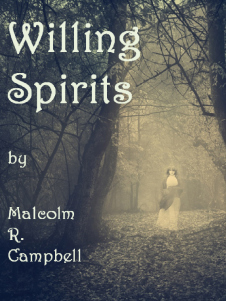 Prudence is a student who isn’t always prudent. Let us point to the night before her school book report is due. She hasn’t finished reading the book. Time to panic?
Prudence is a student who isn’t always prudent. Let us point to the night before her school book report is due. She hasn’t finished reading the book. Time to panic?
Perhaps, for the spirit of the book’s long-gone author seems to have appeared in Prudence’s bedroom. Off hand, this can’t be good.
Opening Lines
“The power went out when Prudence Lowe began reading chapter two of Hope Trueblood. The darkness startled her and the book fell to the floor with a thud. Her bedroom window rattled in the wind bringing St. Louis its first snowfall of the year. She knocked her hairbrush and several makeup bottles off the vanity while searching with gloved hands for the power outage candle. Frugal to a fault, her father kept the house colder than a morgue throughout the winter.”
Enjoy the story!
–Malcolm






